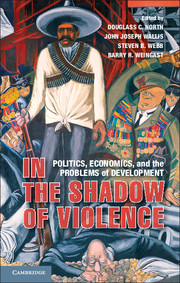Book contents
- Frontmatter
- Contents
- Contributors
- Acknowledgments
- One Limited Access Orders
- Two Bangladesh
- Three Fragile States, Elites, and Rents in the Democratic Republic of Congo (DRC)
- Four Seeking the Elusive Developmental Knife Edge
- Five Change and Continuity in a Limited Access Order
- Six India’s Vulnerable Maturity
- Seven Entrenched Insiders
- Eight From Limited Access to Open Access Order in Chile, Take Two
- Nine Transition from a Limited Access Order to an Open Access Order
- Ten Lessons
- Index
- References
Eight - From Limited Access to Open Access Order in Chile, Take Two
Published online by Cambridge University Press: 05 December 2012
- Frontmatter
- Contents
- Contributors
- Acknowledgments
- One Limited Access Orders
- Two Bangladesh
- Three Fragile States, Elites, and Rents in the Democratic Republic of Congo (DRC)
- Four Seeking the Elusive Developmental Knife Edge
- Five Change and Continuity in a Limited Access Order
- Six India’s Vulnerable Maturity
- Seven Entrenched Insiders
- Eight From Limited Access to Open Access Order in Chile, Take Two
- Nine Transition from a Limited Access Order to an Open Access Order
- Ten Lessons
- Index
- References
Summary
Introduction
After having failed at transitioning from a limited access order (LAO) to an open access order (OAO) in the 1970s, Chile embarked on a second transition starting in 1990. If the democratic breakdown of 1973 dramatically proved the failure of the first transition, the consolidation of democracy and sustained economic growth experienced since the end of the Pinochet regime are symptoms of the presence of the three doorstep conditions necessary for an OAO to exist. The institutional structure that fosters gradualism and pragmatism and that guarantees private property rights – and that evolved out of the authoritarian enclaves left in place by the outgoing dictatorship – have allowed the doorstep conditions to become relatively permanent features of the social, economic, and political order in Chile. The solid economic growth in the 1990–2010 period, due to market-friendly policies, has allowed the government to adopt ambitious poverty reduction initiatives and other socially inclusive policies and has helped consolidate and legitimize the political and economic model. If Chile continues on this path, the nation will become the first Latin American country to complete a transition to an OAO. In what follows, I first discuss the previous failed experience of transitioning from an LAO to an OAO (1925–73) and, drawing lessons from those failed experiences, I then discuss the successful experience of economic growth and democratic consolidation since the end of the dictatorship in 1990.
- Type
- Chapter
- Information
- In the Shadow of ViolencePolitics, Economics, and the Problems of Development, pp. 261 - 292Publisher: Cambridge University PressPrint publication year: 2012
References
- 2
- Cited by

